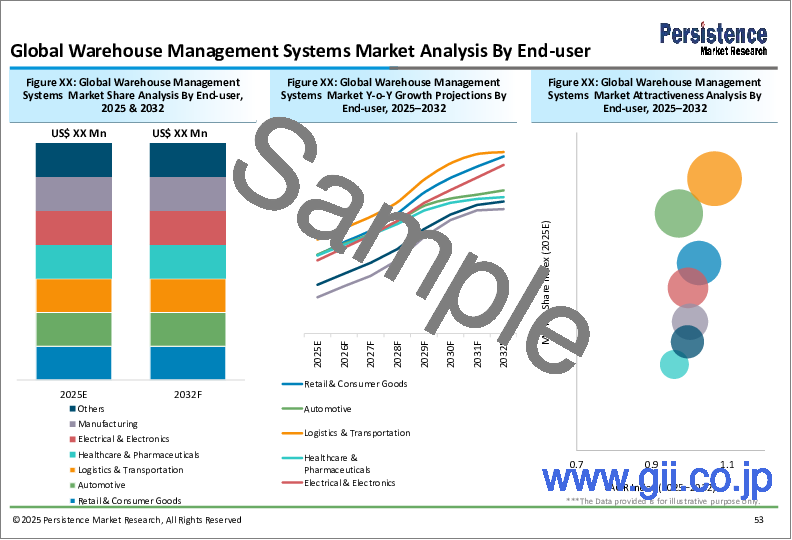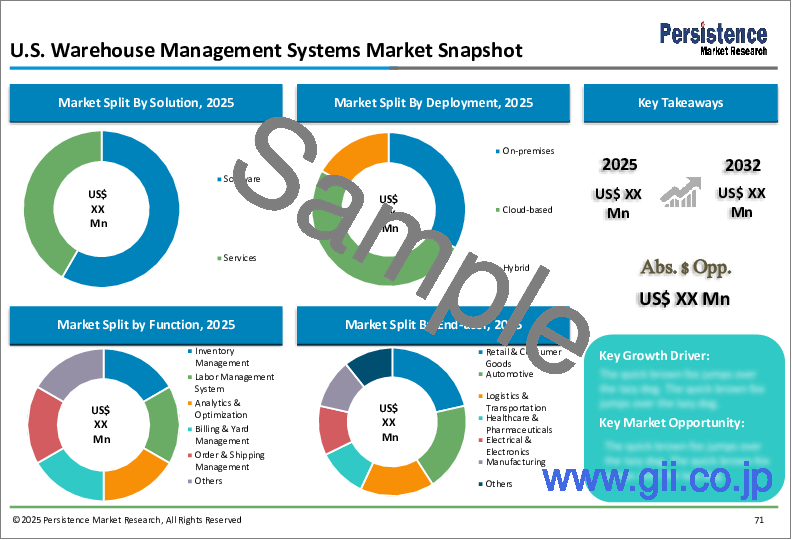|
|
市場調査レポート
商品コード
1701679
倉庫管理システムの世界市場:業界分析、規模、シェア、成長、動向、予測(2025年~2032年)Warehouse Management Systems Market: Global Industry Analysis, Size, Share, Growth, Trends, and Forecast, 2025 - 2032 |
||||||
カスタマイズ可能
|
|||||||
| 倉庫管理システムの世界市場:業界分析、規模、シェア、成長、動向、予測(2025年~2032年) |
|
出版日: 2025年04月09日
発行: Persistence Market Research
ページ情報: 英文 450 Pages
納期: 2~5営業日
|
- 全表示
- 概要
- 目次
世界の倉庫管理システムの市場規模は、2025年に46億7,400万米ドルになるとみられ、2025年~2032年の予測期間に15.1%のCAGRで拡大し、2032年には125億880万米ドルに達すると予測されています。
倉庫管理システム(WMS)は、在庫追跡、注文処理、サプライチェーン統合など、倉庫業務の管理と最適化に企業が使用する不可欠なツールです。この市場を牽引しているのは、各業界における急速なデジタル変革、在庫をリアルタイムで可視化するニーズの高まり、ロジスティクスにおける自動化の導入拡大です。世界のeコマースとオムニチャネル小売の拡大に伴い、俊敏性、拡張性、統合性を提供する堅牢なWMSソリューションへの需要が大幅に高まっています。
世界の倉庫管理システム市場の成長は、いくつかの重要な要因によって推進されています。リアルタイムの在庫管理と倉庫の自動化に対するニーズの高まりが主な要因です。eコマースブーム、世界サプライチェーンの拡大、即日配送サービスの需要が高度なWMSの採用を促進しています。IoT、AI、クラウドコンピューティングなどの技術革新は、WMS機能をさらに強化し、倉庫業務の精度、コスト効率、生産性の向上につながります。
WMS市場は高い成長の可能性を秘めているもの、初期投資コストの高さやレガシーシステムとの統合の複雑さといった課題に直面しています。中小企業は、予算の制約やシステム導入に必要な技術的専門知識の不足に悩まされることが多いです。また、特に新興経済諸国では、データ・セキュリティーへの懸念や移行段階での運用中断も、普及のハードルとなっています。
スケーラブルでクラウドベースの倉庫ソリューションに対する需要の高まりにより、WMS市場には大きなビジネスチャンスが存在します。ロジスティクスにおけるデジタルトランスフォーメーションの進行動向と、倉庫自動化のためのロボット工学とAIの統合は、市場拡大の新たな道を開きます。新興国市場、特にアジアとラテンアメリカは、インフラ整備とeコマースの普及拡大により、大きな成長の可能性を見せています。さらに、ヘルスケア、医薬品、エレクトロニクスなどの業界では、効率性とコンプライアンスを確保するために先進的なWMSを採用する傾向が強まっています。
当レポートでは、世界の倉庫管理システム市場について調査し、コンポーネント別、導入別、用途別、業界別、地域別動向、および市場に参入する企業のプロファイルなどを提供しています。
目次
第1章 エグゼクティブサマリー
第2章 市場概要
第3章 主要な市場動向
第4章 価格分析
- 倉庫管理システム別価格分析
- 平均価格分析ベンチマーク
第5章 世界の倉庫管理システム市場の見通し、2019年~2032年
- 過去の市場金額分析、2019年~2024年
- 現在および将来の市場金額予測、2025年~2032年
第6章 市場背景
第7章 世界の倉庫管理システム市場の見通し、2019年~2032年、コンポーネント別
- イントロダクション/主な調査結果
- 過去の市場規模分析、2019年~2024年、コンポーネント別
- 現在および将来の市場規模分析および予測、2025年~2032年、コンポーネント別
- ハードウェア
- ソフトウェア
- サービス
- コンポーネント別の市場の魅力分析
第8章 世界の倉庫管理システム市場の見通し、2019年~2032年、導入別
- イントロダクション/主な調査結果
- 過去の市場規模分析、2019年~2024年、導入別
- 現在および将来の市場規模分析および予測、2025年~2032年、導入別
- オンプレミス
- クラウド
- 導入別の市場の魅力分析
第9章 世界の倉庫管理システム市場の見通し、2019年~2032年、用途別
- イントロダクション/主な調査結果
- 過去の市場規模分析、2019年~2024年、用途別
- 現在および将来の市場規模分析および予測、2025年~2032年、用途別
- 在庫管理
- 購入および注文管理
- サプライチェーンマネジメント
- 資産運用管理
- その他
- 用途別の市場の魅力分析
第10章 世界の倉庫管理システム市場の見通し、2019年~2032年、業界別
- イントロダクション/主な調査結果
- 過去の市場規模分析、2019年~2024年、業界別
- 現在および将来の市場規模分析および予測、2025年~2032年、業界別
- 小売・消費財
- 自動車
- 運輸・物流
- ヘルスケア・医薬品
- 電気・電子
- その他
- 業界別の市場の魅力分析
第11章 世界の倉庫管理システム市場の見通し、2019年~2032年、地域別
- イントロダクション/主な調査結果
- 過去の市場規模分析、2019年~2024年、地域別
- 現在および将来の市場規模分析および予測、2025年~2032年、地域別
- 北米
- ラテンアメリカ
- 欧州
- 東アジア
- 南アジア太平洋
- 中東・アフリカ
- 地域別の市場の魅力分析
第12章 北米の倉庫管理システム市場の見通し、2019年~2032年
第13章 ラテンアメリカの倉庫管理システム市場の見通し、2019年~2032年
第14章 欧州の倉庫管理システム市場の見通し、2019年~2032年
第15章 南アジア・太平洋の倉庫管理システム市場の見通し、2019年~2032年
第16章 東アジアの倉庫管理システム市場の見通し、2019年~2032年
第17章 中東・アフリカの倉庫管理システム市場の見通し、2019年~2032年
第18章 主要国別倉庫管理システム市場分析
- 米国
- カナダ
- メキシコ
- ブラジル
- ドイツ
- イタリア
- フランス
- 英国
- スペイン
- ベネルクス
- ロシア
- 中国
- 日本
- 韓国
- インド
- マレーシア
- インドネシア
- シンガポール
- オーストラリアとニュージーランド
- GCC諸国
- トルコ
- 南アフリカ
第19章 市場構造分析
- 企業階層別の市場分析
- 主要企業別の市場シェア分析
第20章 競合分析
- 競合ダッシュボード
- 競合の詳細
- Zebra Technologies
- Honeywell International Inc.
- Clearpath Robotics Inc.
- The Raymond Corporation
- Technology Solutions(UK)Ltd.
- SAP
- Zoho Corp.
- Oracle Corporation
- Infor
- PTC
第21章 前提と使用される頭字語
第22章 調査手法
Persistence Market Research has recently released a comprehensive report on the global Warehouse Management Systems (WMS) Market, providing an in-depth analysis of key market dynamics, including driving factors, emerging trends, opportunities, and challenges. This report delivers detailed insights into market structure and forecasts, enabling stakeholders to make informed strategic decisions.
Key Insights:
- Warehouse Management Systems Market Size (2025E): US$ 4,674.0 Mn
- Projected Market Value (2032F): US$ 12,508.8 Mn
- Global Market Growth Rate (CAGR 2025 to 2032): 15.1%
Warehouse Management Systems Market - Report Scope:
Warehouse Management Systems (WMS) are essential tools used by businesses to manage and optimize warehouse operations including inventory tracking, order fulfillment, and supply chain integration. The market is being driven by rapid digital transformation across industries, the growing need for real-time visibility into inventory, and the increasing adoption of automation in logistics. As global e-commerce and omnichannel retailing expand, the demand for robust WMS solutions that offer agility, scalability, and integration is rising significantly.
Market Growth Drivers:
The growth of the global Warehouse Management Systems market is propelled by several key factors. The increasing need for real-time inventory control and warehouse automation is a major contributor. E-commerce boom, global supply chain expansion, and the demand for same-day delivery services are fueling the adoption of advanced WMS. Technological innovations such as IoT, AI, and cloud computing are further enhancing WMS capabilities, leading to better accuracy, cost-efficiency, and productivity in warehouse operations.
Market Restraints:
Despite the high growth potential, the WMS market faces challenges such as high initial investment costs and complexities in integration with legacy systems. Small and medium-sized enterprises (SMEs) often struggle with budget constraints and lack of technical expertise required for system implementation. Data security concerns and operational disruptions during transition phases also pose hurdles for widespread adoption, particularly in developing economies.
Market Opportunities:
Significant opportunities exist in the WMS market due to increasing demand for scalable and cloud-based warehouse solutions. The ongoing trend of digital transformation in logistics and the integration of robotics and AI for warehouse automation open new avenues for market expansion. Emerging markets, particularly in Asia and Latin America, are showing strong growth potential due to infrastructure development and growing e-commerce penetration. Additionally, industries such as healthcare, pharmaceuticals, and electronics are increasingly turning to advanced WMS to ensure efficiency and compliance.
Key Questions Answered in the Report:
- What are the primary factors driving the global growth of the Warehouse Management Systems market?
- Which regions and industries are showing the highest adoption of WMS solutions?
- How are technological advancements transforming the competitive landscape of the WMS market?
- Who are the key players in the Warehouse Management Systems market, and what strategies are they implementing?
- What are the emerging trends and long-term outlook for the WMS market across different sectors?
Competitive Intelligence and Business Strategy:
Leading players in the global Warehouse Management Systems market, including Zebra Technologies, Honeywell International Inc., and Oracle Corporation, are focusing on product innovation, cloud integration, and strategic acquisitions to enhance their market positioning. Companies are also collaborating with logistics providers and e-commerce players to tailor solutions that address specific operational needs. Emphasis on AI-powered predictive analytics, robotics integration, and customer-centric features remains central to staying competitive in a rapidly evolving logistics environment.
Key Companies Profiled:
- Zebra Technologies
- Honeywell International Inc.
- Clearpath Robotics Inc.
- The Raymond Corporation
- Technology Solutions (UK) Ltd.
- SAP
- Zoho Corp.
- Oracle Corporation
- Infor
- PTC
Warehouse Management Systems Industry Research Segmentation:
By Component:
- Hardware
- Software
- Service
By Deployment Mode:
- Cloud-based
- On-premise
By Application:
- Inventory Management
- Purchase & Order Management
- Supply Chain Management
- Asset Management
- Others
By Industry:
- Retail & Consumer Goods
- Automotive
- Transport & Logistics
- Healthcare & Pharmaceuticals
- Electrical & Electronics
- Others
By Region:
- North America
- Latin America
- Europe
- East Asia
- South Asia Pacific
- Middle East and Africa
Table of Contents
1. Executive Summary
- 1.1. Global Market Outlook
- 1.2. Demand Side Trends
- 1.3. Supply Side Trends
- 1.4. Analysis and Recommendations
2. Market Overview
- 2.1. Market Coverage / Taxonomy
- 2.2. Market Definition / Scope / Limitations
3. Key Market Trends
- 3.1. Key Trends Impacting the Market
- 3.2. Product Innovation / Development Trends
4. Pricing Analysis
- 4.1. Pricing Analysis, By Warehouse Management Systems
- 4.2. Average Pricing Analysis Benchmark
5. Global Warehouse Management Systems Market Outlook, 2019-2032
- 5.1. Historical Market Value (US$ Mn) Analysis, 2019-2024
- 5.2. Current and Future Market Value (US$ Mn) Projections, 2025-2032
- 5.2.1. Y-o-Y Growth Trend Analysis
- 5.2.2. Absolute $ Opportunity Analysis
6. Market Background
- 6.1. Macro-Economic Factors
- 6.2. Forecast Factors - Relevance & Impact
- 6.3. Value Chain
- 6.4. COVID-19 Crisis - Impact Assessment
- 6.4.1. Current Statistics
- 6.4.2. Short-Mid-Long Term Outlook
- 6.4.3. Likely Rebound
- 6.5. Market Dynamics
- 6.5.1. Drivers
- 6.5.2. Restraints
- 6.5.3. Opportunities
7. Global Warehouse Management Systems Market Outlook, 2019-2032, By Component
- 7.1. Introduction / Key Findings
- 7.2. Historical Market Size (US$ Mn) Analysis By Component, 2019-2024
- 7.3. Current and Future Market Size (US$ Mn) Analysis and Forecast By Component, 2025-2032
- 7.3.1. Hardware
- 7.3.1.1. RFID Tags
- 7.3.1.2. Scanners and Readers
- 7.3.1.3. Mobile Computers
- 7.3.2. Software
- 7.3.2.1. Standalone WMS Software
- 7.3.2.2. Integrated WMS Software
- 7.3.2.2.1. Supply Chain Management
- 7.3.2.2.2. ERP System (with WMS Features)
- 7.3.3. Service
- 7.3.3.1. Integration & Deployment
- 7.3.3.2. Support & Maintenance
- 7.3.3.3. Consulting
- 7.3.1. Hardware
- 7.4. Market Attractiveness Analysis By Component
8. Global Warehouse Management Systems Market Outlook, 2019-2032, By Deployment
- 8.1. Introduction / Key Findings
- 8.2. Historical Market Size (US$ Mn) Analysis By Deployment, 2019-2024
- 8.3. Current and Future Market Size (US$ Mn) Analysis and Forecast By Deployment, 2025-2032
- 8.3.1. On-premise
- 8.3.2. Cloud
- 8.4. Market Attractiveness Analysis By Deployment
9. Global Warehouse Management Systems Market Outlook, 2019-2032, By Application
- 9.1. Introduction / Key Findings
- 9.2. Historical Market Size (US$ Mn) Analysis By Application, 2019-2024
- 9.3. Current and Future Market Size (US$ Mn) Analysis and Forecast By Application, 2025-2032
- 9.3.1. Inventory Management
- 9.3.2. Purchase & Order Management
- 9.3.3. Supply Chain Management
- 9.3.4. Asset Management
- 9.3.5. Others
- 9.4. Market Attractiveness Analysis By Application
10. Global Warehouse Management Systems Market Outlook, 2019-2032, By Industry
- 10.1. Introduction / Key Findings
- 10.2. Historical Market Size (US$ Mn) Analysis By Industry, 2019-2024
- 10.3. Current and Future Market Size (US$ Mn) Analysis and Forecast By Industry, 2025-2032
- 10.3.1. Retail & Consumer Goods
- 10.3.2. Automotive
- 10.3.3. Transport & Logistics
- 10.3.4. Healthcare & Pharmaceuticals
- 10.3.5. Electrical & Electronics
- 10.3.6. Others
- 10.4. Market Attractiveness Analysis By Industry
11. Global Warehouse Management Systems Market Outlook, 2019-2032, By Region
- 11.1. Introduction / Key Findings
- 11.2. Historical Market Size (US$ Mn) Analysis By Region, 2019-2024
- 11.3. Current and Future Market Size (US$ Mn) Analysis and Forecast By Region, 2025-2032
- 11.3.1. North America
- 11.3.2. Latin America
- 11.3.3. Europe
- 11.3.4. East Asia
- 11.3.5. South Asia Pacific
- 11.3.6. Middle East and Africa
- 11.4. Market Attractiveness Analysis By Region
12. North America Warehouse Management Systems Market Outlook, 2019-2032
- 12.1. Introduction
- 12.2. Historical Market Size (US$ Mn) Trend Analysis By Market Taxonomy, 2019-2024
- 12.3. Current and Future Market Size (US$ Mn) Forecast By Market Taxonomy, 2025-2032
- 12.3.1. By Component
- 12.3.2. By Deployment
- 12.3.3. By Application
- 12.3.4. By Industry
- 12.3.5. By Country
- 12.3.5.1. U.S.
- 12.3.5.2. Canada
- 12.4. Market Attractiveness Analysis
- 12.4.1. By Component
- 12.4.2. By Deployment
- 12.4.3. By Application
- 12.4.4. By Industry
- 12.4.5. By Country
- 12.5. Market Trends
- 12.6. Key Market Participants - Intensity Mapping
13. Latin America Warehouse Management Systems Market Outlook, 2019-2032
- 13.1. Introduction
- 13.2. Historical Market Size (US$ Mn) Trend Analysis By Market Taxonomy, 2019-2024
- 13.3. Current and Future Market Size (US$ Mn) Forecast By Market Taxonomy, 2025-2032
- 13.3.1. By Component
- 13.3.2. By Deployment
- 13.3.3. By Application
- 13.3.4. By Industry
- 13.3.5. By Country
- 13.3.5.1. Brazil
- 13.3.5.2. Mexico
- 13.3.5.3. Rest of Latin America
- 13.4. Market Attractiveness Analysis
- 13.4.1. By Component
- 13.4.2. By Deployment
- 13.4.3. By Application
- 13.4.4. By Industry
- 13.4.5. By Country
14. Europe Warehouse Management Systems Market Outlook, 2019-2032
- 14.1. Introduction
- 14.2. Historical Market Size (US$ Mn) Trend Analysis By Market Taxonomy, 2019-2024
- 14.3. Current and Future Market Size (US$ Mn) Forecast By Market Taxonomy, 2025-2032
- 14.3.1. By Component
- 14.3.2. By Deployment
- 14.3.3. By Application
- 14.3.4. By Industry
- 14.3.5. By Country
- 14.3.5.1. Germany
- 14.3.5.2. Italy
- 14.3.5.3. France
- 14.3.5.4. U.K.
- 14.3.5.5. Spain
- 14.3.5.6. BENELUX
- 14.3.5.7. Russia
- 14.3.5.8. Rest of Europe
- 14.4. Market Attractiveness Analysis
- 14.4.1. By Component
- 14.4.2. By Deployment
- 14.4.3. By Application
- 14.4.4. By Industry
- 14.4.5. By Country
15. South Asia & Pacific Warehouse Management Systems Market Outlook, 2019-2032
- 15.1. Introduction
- 15.2. Historical Market Size (US$ Mn) Trend Analysis By Market Taxonomy, 2019-2024
- 15.3. Current and Future Market Size (US$ Mn) Forecast By Market Taxonomy, 2025-2032
- 15.3.1. By Component
- 15.3.2. By Deployment
- 15.3.3. By Application
- 15.3.4. By Industry
- 15.3.5. By Country
- 15.3.5.1. India
- 15.3.5.2. Indonesia
- 15.3.5.3. Malaysia
- 15.3.5.4. Singapore
- 15.3.5.5. Australia & New Zealand
- 15.3.5.6. Rest of South Asia and Pacific
- 15.4. Market Attractiveness Analysis
- 15.4.1. By Component
- 15.4.2. By Deployment
- 15.4.3. By Application
- 15.4.4. By Industry
- 15.4.5. By Country
16. East Asia Warehouse Management Systems Market Outlook, 2019-2032
- 16.1. Introduction
- 16.2. Historical Market Size (US$ Mn) Trend Analysis By Market Taxonomy, 2019-2024
- 16.3. Current and Future Market Size (US$ Mn) Forecast By Market Taxonomy, 2025-2032
- 16.3.1. By Component
- 16.3.2. By Deployment
- 16.3.3. By Application
- 16.3.4. By Industry
- 16.3.5. By Country
- 16.3.5.1. China
- 16.3.5.2. Japan
- 16.3.5.3. South Korea
- 16.4. Market Attractiveness Analysis
- 16.4.1. By Component
- 16.4.2. By Deployment
- 16.4.3. By Application
- 16.4.4. By Industry
- 16.4.5. By Country
17. Middle East and Africa Warehouse Management Systems Market Outlook, 2019-2032
- 17.1. Introduction
- 17.2. Historical Market Size (US$ Mn) Trend Analysis By Market Taxonomy, 2019-2024
- 17.3. Current and Future Market Size (US$ Mn) Forecast By Market Taxonomy, 2025-2032
- 17.3.1. By Component
- 17.3.2. By Deployment
- 17.3.3. By Application
- 17.3.4. By Industry
- 17.3.5. By Country
- 17.3.5.1. GCC Countries
- 17.3.5.2. Turkey
- 17.3.5.3. South Africa
- 17.3.5.4. Rest of Middle East and Africa
- 17.4. Market Attractiveness Analysis
- 17.4.1. By Component
- 17.4.2. By Deployment
- 17.4.3. By Application
- 17.4.4. By Industry
- 17.4.5. By Country
18. Key Countries Analysis - Warehouse Management Systems Market
- 18.1. U.S. Warehouse Management Systems Market Analysis
- 18.1.1. By Component
- 18.1.2. By Deployment
- 18.1.3. By Application
- 18.1.4. By Industry
- 18.2. Canada Warehouse Management Systems Market Analysis
- 18.2.1. By Component
- 18.2.2. By Deployment
- 18.2.3. By Application
- 18.2.4. By Industry
- 18.3. Mexico Warehouse Management Systems Market Analysis
- 18.3.1. By Component
- 18.3.2. By Deployment
- 18.3.3. By Application
- 18.3.4. By Industry
- 18.4. Brazil Warehouse Management Systems Market Analysis
- 18.4.1. By Component
- 18.4.2. By Deployment
- 18.4.3. By Application
- 18.4.4. By Industry
- 18.5. Germany Warehouse Management Systems Market Analysis
- 18.5.1. By Component
- 18.5.2. By Deployment
- 18.5.3. By Application
- 18.5.4. By Industry
- 18.6. Italy Warehouse Management Systems Market Analysis
- 18.6.1. By Component
- 18.6.2. By Deployment
- 18.6.3. By Application
- 18.6.4. By Industry
- 18.7. France Warehouse Management Systems Market Analysis
- 18.7.1. By Component
- 18.7.2. By Deployment
- 18.7.3. By Application
- 18.7.4. By Industry
- 18.8. U.K. Warehouse Management Systems Market Analysis
- 18.8.1. By Component
- 18.8.2. By Deployment
- 18.8.3. By Application
- 18.8.4. By Industry
- 18.9. Spain Warehouse Management Systems Market Analysis
- 18.9.1. By Component
- 18.9.2. By Deployment
- 18.9.3. By Application
- 18.9.4. By Industry
- 18.10. BENELUX Warehouse Management Systems Market Analysis
- 18.10.1. By Component
- 18.10.2. By Deployment
- 18.10.3. By Application
- 18.10.4. By Industry
- 18.11. Russia Warehouse Management Systems Market Analysis
- 18.11.1. By Component
- 18.11.2. By Deployment
- 18.11.3. By Application
- 18.11.4. By Industry
- 18.12. China Warehouse Management Systems Market Analysis
- 18.12.1. By Component
- 18.12.2. By Deployment
- 18.12.3. By Application
- 18.12.4. By Industry
- 18.13. Japan Warehouse Management Systems Market Analysis
- 18.13.1. By Component
- 18.13.2. By Deployment
- 18.13.3. By Application
- 18.13.4. By Industry
- 18.14. South Korea Warehouse Management Systems Market Analysis
- 18.14.1. By Component
- 18.14.2. By Deployment
- 18.14.3. By Application
- 18.14.4. By Industry
- 18.15. India Warehouse Management Systems Market Analysis
- 18.15.1. By Component
- 18.15.2. By Deployment
- 18.15.3. By Application
- 18.15.4. By Industry
- 18.16. Malaysia Warehouse Management Systems Market Analysis
- 18.16.1. By Component
- 18.16.2. By Deployment
- 18.16.3. By Application
- 18.16.4. By Industry
- 18.17. Indonesia Warehouse Management Systems Market Analysis
- 18.17.1. By Component
- 18.17.2. By Deployment
- 18.17.3. By Application
- 18.17.4. By Industry
- 18.18. Singapore Warehouse Management Systems Market Analysis
- 18.18.1. By Component
- 18.18.2. By Deployment
- 18.18.3. By Application
- 18.18.4. By Industry
- 18.19. Australia and New Zealand Warehouse Management Systems Market Analysis
- 18.19.1. By Component
- 18.19.2. By Deployment
- 18.19.3. By Application
- 18.19.4. By Industry
- 18.20. GCC Countries Warehouse Management Systems Market Analysis
- 18.20.1. By Component
- 18.20.2. By Deployment
- 18.20.3. By Application
- 18.20.4. By Industry
- 18.21. Turkey Warehouse Management Systems Market Analysis
- 18.21.1. By Component
- 18.21.2. By Deployment
- 18.21.3. By Application
- 18.21.4. By Industry
- 18.22. South Africa Warehouse Management Systems Market Analysis
- 18.22.1. By Component
- 18.22.2. By Deployment
- 18.22.3. By Application
- 18.22.4. By Industry
19. Market Structure Analysis
- 19.1. Market Analysis by Tier of Companies
- 19.2. Market Share Analysis of Top Players
20. Competition Analysis
- 20.1. Competition Dashboard
- 20.2. Competition Deep Dive
- 20.2.1. Zebra Technologies
- 20.2.1.1. Business Overview
- 20.2.1.2. Solution Portfolio
- 20.2.1.3. Profitability by Market Segments (Business Segments/Region)
- 20.2.1.4. Key Strategy & Developments
- 20.2.2. Honeywell International Inc.
- 20.2.2.1. Business Overview
- 20.2.2.2. Solution Portfolio
- 20.2.2.3. Profitability by Market Segments (Business Segments/Region)
- 20.2.2.4. Key Strategy & Developments
- 20.2.3. Clearpath Robotics Inc.
- 20.2.3.1. Business Overview
- 20.2.3.2. Solution Portfolio
- 20.2.3.3. Profitability by Market Segments (Business Segments/Region)
- 20.2.3.4. Key Strategy & Developments
- 20.2.4. The Raymond Corporation
- 20.2.4.1. Business Overview
- 20.2.4.2. Solution Portfolio
- 20.2.4.3. Profitability by Market Segments (Business Segments/Region)
- 20.2.4.4. Key Strategy & Developments
- 20.2.5. Technology Solutions (UK) Ltd.
- 20.2.5.1. Business Overview
- 20.2.5.2. Solution Portfolio
- 20.2.5.3. Profitability by Market Segments (Business Segments/Region)
- 20.2.5.4. Key Strategy & Developments
- 20.2.6. SAP
- 20.2.6.1. Business Overview
- 20.2.6.2. Solution Portfolio
- 20.2.6.3. Profitability by Market Segments (Business Segments/Region)
- 20.2.6.4. Key Strategy & Developments
- 20.2.7. Zoho Corp.
- 20.2.7.1. Business Overview
- 20.2.7.2. Solution Portfolio
- 20.2.7.3. Profitability by Market Segments (Business Segments/Region)
- 20.2.7.4. Key Strategy & Developments
- 20.2.8. Oracle Corporation
- 20.2.8.1. Business Overview
- 20.2.8.2. Solution Portfolio
- 20.2.8.3. Profitability by Market Segments (Business Segments/Region)
- 20.2.8.4. Key Strategy & Developments
- 20.2.9. Infor
- 20.2.9.1. Business Overview
- 20.2.9.2. Solution Portfolio
- 20.2.9.3. Profitability by Market Segments (Business Segments/Region)
- 20.2.9.4. Key Strategy & Developments
- 20.2.10. PTC
- 20.2.10.1. Business Overview
- 20.2.10.2. Solution Portfolio
- 20.2.10.3. Profitability by Market Segments (Business Segments/Region)
- 20.2.10.4. Key Strategy & Developments
- 20.2.1. Zebra Technologies






